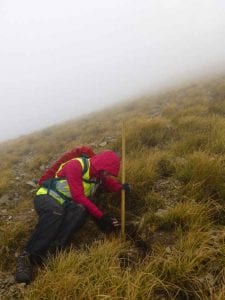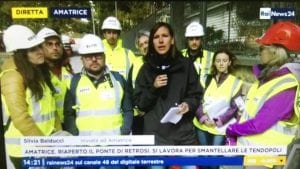Five members of the IRDR visit Amatrice as part of the EEFIT mission
By Zoe Mildon, on 21 October 2016
Six weeks after the earthquake that struck Amatrice, central Italy, EEFIT (Earthquake Engineering Field Investigation Team) deployed a team to the region to investigate the damages. The team involved five members of the IRDR; Prof. David Alexander, Dr Joanna Faure Walker, Dr Carmine Galasso and PhD students Zoe Mildon and Serena Tagliacozzo.
Joanna and Zoe’s main aim of the trip was to map the surface ruptures from the earthquake. Slip at depth along the fault plane that generated the earthquake came to the surface, and could be seen as offset soils and open cracks along the slope of Mt Vettore. By measuring the orientation and offset of the rupture, they hope to gain a better understanding of the earthquake process. In addition, they worked together with Domenico Lombardi (Uni. Manchester) to look at the environmental effects of the earthquake, such as landslides, rock falls and ground cracks. They were using the Environmental Seismic Intensity Scale (ESI 2007) which aims to provide a measure of the intensity of shaking during an earthquake, similar to the Modified Mercalli Scale, but from only considering effects to the environment.
Carmine’s primary interest was to investigate strong ground motion signals recorded at various seismic stations around the epicentral area. Areas of particular interest included the three stations closest to the earthquake that recorded the highest PGA (Peak Ground Acceleration). One of these was close to the Umbrian town of Norcia that recorded among the highest ground motion measurement, yet the town was relatively undamaged. Three stations ~50km north-west of the epicentre also recorded unusually strong ground motions and these were visited as well to determine if there were any site specific effects that may explain these high measurements. He also worked with other members of the EEFIT team to do rapid surveys of building damage.
David and Serena were interested in investigating the social effects of the disaster and how local communities were responding to it. They started by interviewing relief workers from various agencies, including the Civil Protection and Red Cross (Croce Rossa). They also visited L’Aquila, 40km to the south-east of the Amatrice epicentral area, as the city experienced a similar magnitude earthquake in 2009 and they were interested in the progress of reconstruction and the availability of the services to displaced communities.
All members also visited the town of Amatrice and surrounding villages to observe the damage. We would like to thank the Civil Protection Authorities and Vigil del Fuoco for their help and assistance during this trip.
Further detail about other members of the EEFIT trip and activities can be found at the mission blog. An EEFIT report will be released in the near future and there will be a presentation organised for late November to present the initial findings.
 Close
Close




